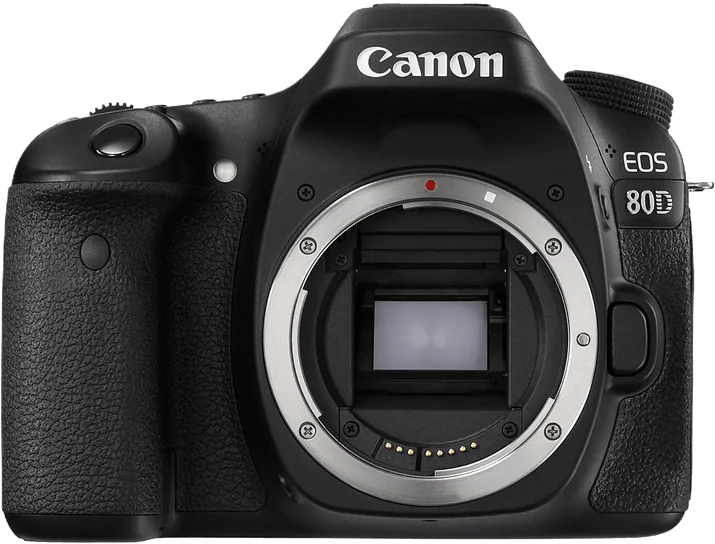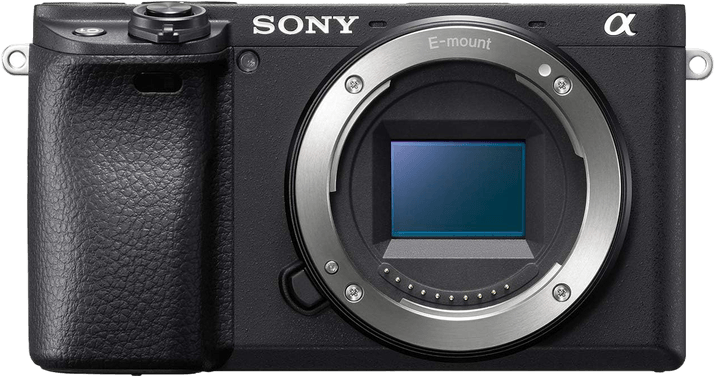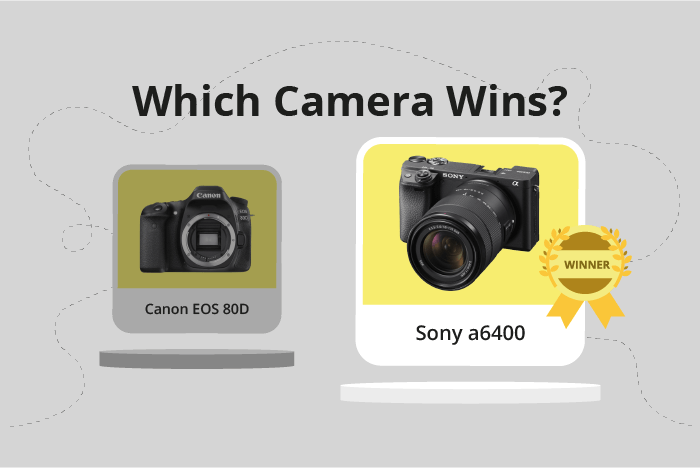Canon EOS 80D vs Sony a6400 Comparison
Canon EOS 80D

Sony a6400

The Sony a6400 outperforms the Canon EOS 80D with a score of 70/100 compared to 64/100. Both cameras share some common features, such as being released in the 2010s and having similar launch prices. However, the Sony a6400 is a mirrorless camera, while the Canon EOS 80D is a DSLR.
The Sony a6400 has the advantage of being smaller and lighter, with dimensions of 120 x 67 x 60mm and a weight of 403g. On the other hand, the Canon EOS 80D is bulkier, measuring 139 x 105 x 79mm and weighing 730g. The Sony’s compact size and lighter weight make it more portable and convenient for users.
Despite its size, the Canon EOS 80D may offer some advantages in terms of ergonomics and handling for certain users who prefer a heftier camera. However, the Sony a6400’s higher score and smaller size indicate that it is the better choice for most photographers.
Canon EOS 80D vs Sony a6400 Overview and Optics
The Sony a6400 wins in the optics comparison with a score of 68/100, while the Canon EOS 80D scores 63/100. Both cameras share common specifications, such as 24.2 megapixels, CMOS sensor type, APS-C sensor size, and lack of image stabilization. However, there are significant differences between the two cameras that contribute to their respective scores.
The Sony a6400 has a faster shooting speed of 11 frames per second compared to the Canon EOS 80D’s 7 frames per second. This makes the Sony a6400 better suited for capturing fast-moving subjects and continuous shooting. Additionally, the Sony a6400’s sensor has a higher DXOMARK score of 83, compared to the Canon EOS 80D’s score of 79. This means that the Sony a6400’s sensor performs better in terms of color depth, dynamic range, and low light performance.
The Canon EOS 80D, on the other hand, has a Digic 6 processor, while the Sony a6400 is equipped with a Bionz X processor. Although both processors are powerful, the Bionz X processor is known for its faster processing speed and better noise reduction capabilities. The Canon EOS 80D has a Canon EF-S lens mount, while the Sony a6400 uses a Sony E lens mount. This difference in lens mounts may affect users’ lens options and compatibility with existing lenses.
Taking these points into consideration, the Sony a6400 is the better option for those who prioritize faster shooting speeds, better sensor performance, and a more advanced processor. However, the Canon EOS 80D may still be a suitable choice for those who prefer the Canon EF-S lens mount and are willing to compromise on the other mentioned specifications.
Canon EOS 80D vs Sony a6400 Video Performance
The Sony a6400 outperforms the Canon EOS 80D in video capabilities with a score of 91/100, a significant 21-point lead over the EOS 80D’s score of 70/100. Both cameras share time-lapse functionality, providing users with the ability to create stunning time-lapse videos.
The Sony a6400 excels in its maximum video resolution, offering 4K (3840 x 2160) compared to the Canon EOS 80D’s Full HD (1920 x 1080). This higher resolution allows for sharper and more detailed videos, making the a6400 a superior choice for videographers and content creators. Additionally, the a6400 has a maximum video frame rate of 120fps, double the EOS 80D’s 60fps. This higher frame rate enables smoother slow-motion footage, further enhancing the a6400’s video capabilities.
While the Canon EOS 80D falls short in resolution and frame rate, it remains a solid choice for those primarily focused on photography with occasional video needs. Its Full HD resolution is sufficient for casual video recording and sharing on social media platforms. However, for users prioritizing video quality and performance, the Sony a6400 is the clear winner.
When comparing the video capabilities of the Canon EOS 80D and the Sony a6400, the a6400’s superior resolution, frame rate, and overall video score make it the better choice for videographers and content creators. The Canon EOS 80D remains a viable option for those with less demanding video requirements but should not be the primary choice for users focused on video quality.
Canon EOS 80D vs Sony a6400 Features and Benefits
The Sony a6400 wins in the features category with a score of 81/100, while the Canon EOS 80D receives a score of 70/100. Both cameras share several specifications, including a 3-inch screen size, touchscreen functionality, flip screen, lack of GPS, and WIFI connectivity.
The Sony a6400 surpasses the Canon EOS 80D due to its additional bluetooth feature. This allows for better connectivity and easier transfer of files between devices. The screen resolution of the a6400 is also slightly higher at 921,600 dots compared to the EOS 80D’s 1,040,000 dots. This results in a sharper and more detailed display for the a6400.
On the other hand, the Canon EOS 80D does not have any significant advantages over the Sony a6400 in terms of features. The only possible advantage is the marginally higher screen resolution, which may not be substantial enough to make a noticeable difference.
Based on these points, the Sony a6400 offers better connectivity and a slightly improved display compared to the Canon EOS 80D. The Canon EOS 80D does not have any notable advantages in this area. As a result, the Sony a6400 is the superior choice in terms of features.
Canon EOS 80D vs Sony a6400 Storage and Battery
The Canon EOS 80D outperforms the Sony a6400 in storage and battery with a score of 43/100 compared to the Sony’s 37/100. Both cameras have a single memory card slot and accept SD, SDHC, and SDXC cards with UHS-I compatibility. However, the Sony a6400 also supports Memory Stick Duo cards.
The EOS 80D has a significantly longer battery life, allowing for 960 shots per charge, while the a6400 only manages 410 shots. The Canon uses an LP-E6N battery, whereas the Sony relies on an NP-FW50 battery. Despite its shorter battery life, the Sony a6400 has the advantage of USB charging, which the Canon EOS 80D lacks.
In terms of storage and battery, the Canon EOS 80D offers better performance with its longer battery life. The Sony a6400, however, provides more flexibility in memory card options and the convenience of USB charging.
Canon EOS 80D vs Sony a6400 – Our Verdict
Are you still undecided about which camera is right for you? Have a look at these popular comparisons that feature the Canon EOS 80D or the Sony a6400:

